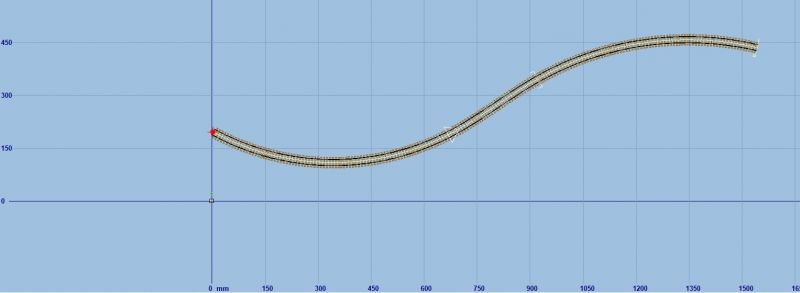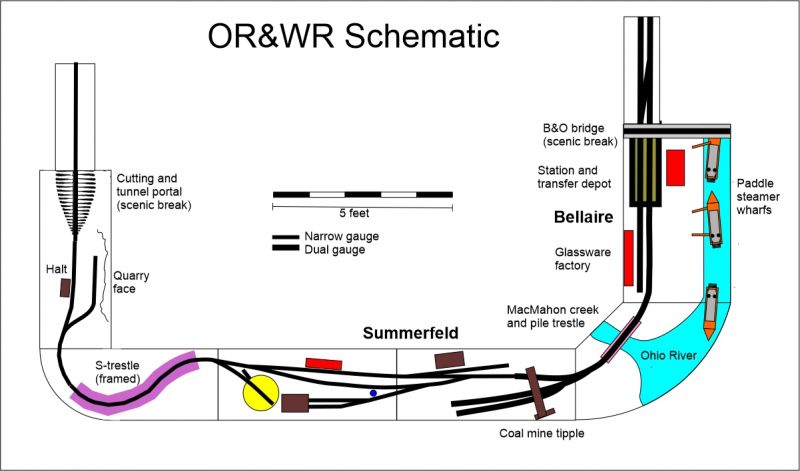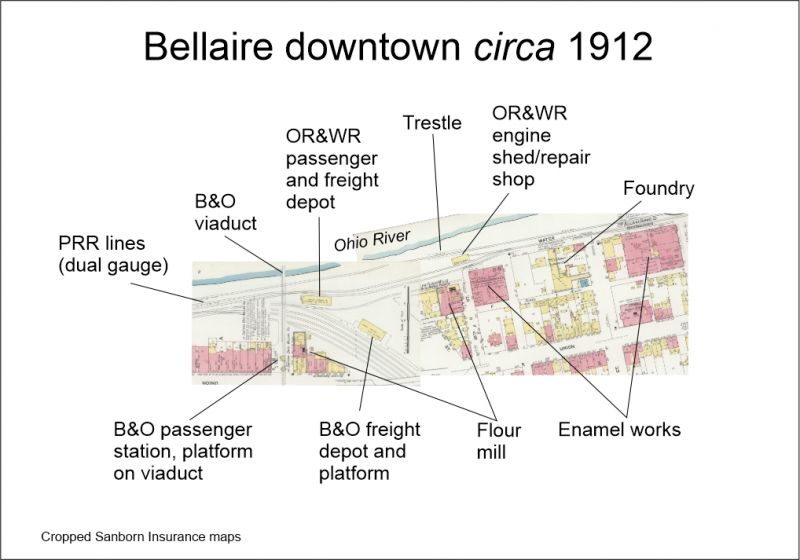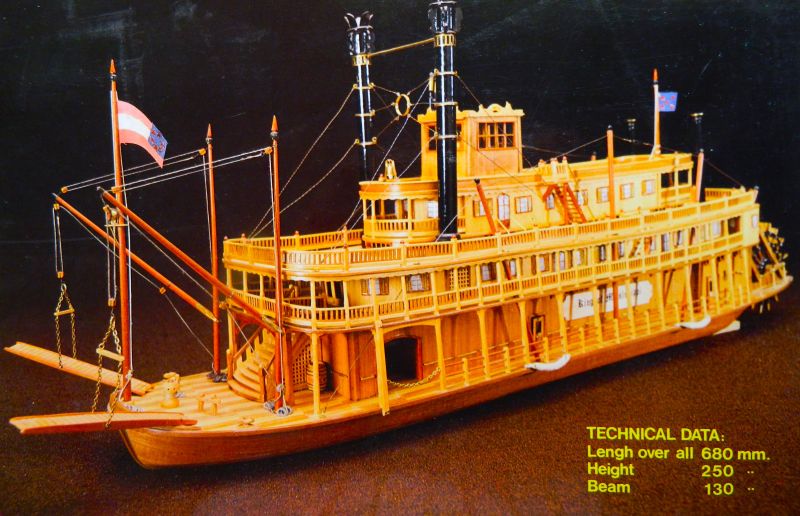Ohio River and Western Railroad
Posted
#264233
(In Topic #14385)
Full Member
On30 narrow gauge set in the Appalachian Plateau circa 1912
Hi All,New topic, same subject - the Ohio River and Western Railroad - but with a change of scale. Instead of HOn3 I'm going back to one of my favorite scales - On30. Over here this means a scale of 1:48, in the UK this corresponds to 1:43. It will mean bigger baseboards than I planned, but as this is a small layout with cameo scenes and intended to be broken down into modules for storage that shouldn't be an issue.
Why the change in scale? The Ohio and Western used a variety of second hand steam locomotives - 2-8-0, 2-6-0, 4-6-0 and 4-4-0 - and they were proving to be problematic to source in HOn3. Plenty of 2-8-0 locomotives (for a price, most are old brass models dating from the 1960s and 1970s with coffee grinder gears and motors to match), but the others? Hen's teeth territory. And at make your eyes water pricing when the odd one comes on the market. Luckily I only have one 2-8-0 in this scale, currently undergoing a motor and worm change, and one boxcar, built from a kit. Looking at the stock available (principally on eBay) and checking prices of locomotives freight and passenger cars there is a premium of between 30% and 100% compared to HO. Blackstone, a division of Soundtraxx, are one of the few companies to make new stock (and very sporadically at that). One of their HOn3 2-6-0s came up on eBay recently - $800+. At least it was DCC sound. Supply and demand I guess. I realized I had hit a wall.
The On30 stock supply is much more robust (and a lot more modern). I can happily trade the availability of stock against the inaccuracy of gauge (2'6" versus 3'). Bachmann here invested heavily in this scale, and it is possible to get new stock, in addition to what comes up s/h. Good spares supply from Bachmann as well. While new 4-4-0 models are a bit difficult to find, it's possible to source the complete locomotive from their spares catalog (running chassis, body shell, tender chassis and top). The other advantage for me is that On30 stock can be bashed from HO or even OO stock and still look realistic. Checking my inventory I have an On30 2-6-0 in storage that was in the process of being converted to DCC. These models are often used for "run around the Christmas tree" train sets, and can be found for $40-$50 s/h, $170 new. Older tooling (they have a split frame chassis, nothing wrong with that) but a good basis for bashing. I also have the electrical/electronic fixings for a motorized turntable (motor, transformer, PWM power supply, polarity changer), just needs a well and bridge to be built.
So that wooden S trestle needs some new plans and templates, and I will need some timbers scaled to 1:48. As most of the timber for the bents is 12" x 12" that means 1/4" square timber. I was tempted by some O-scale kits, but having had a go at some straight trestles in HO I feel confident that I can move onward and upward to O scale. (I also found some plans for those Brunel wooden trestles online, so I've added that to the getaroundtoit list for the EM layout).
Nigel
©Nigel C. Phillips
Posted
Full Member
That sounds like a plan. Available models and track beats the alternative any day. Will look forward to your progress,
Colin
Posted
Full Member
'Petermac
Posted
Full Member
Thanks. Out of interest I loaded the long trestle with 16kg/35.3lbs of weights - not a creak. 2kg a bent. Probably take a lot more.
Nigel
©Nigel C. Phillips
Posted
Full Member
The layout is still in the planning stage, but as usual will be modular - 5 x 2 feet with a total of 5 modules plus some fiddle yards at each end. Just have to remember that this O-scale (1:48) not HO or OO scale (1:87 or 1:76). The station and goods depot/engine shed/turntable will take approximately 1.5 modules. The S-shaped trestle will take pretty much all of another 5-foot module. So out of interest I looked up what sort of radii an S-trestle would have the given the constraints of the 5 x 2 foot module. The one I want to represent had curves of 21 and 18 degrees. Taking a look at the table in https://www.railwayeng.com/Track/Curves.htm for On3 (the closest scale/gauge I could find) this corresponds to radii of 68.6" and 79.6" respectively. Ouch! Even moving down to HO scale they are still large radii - 37.8" and 46.6", and way over 5 feet in length.
The Bachmann locomotives that will run on the layout are quite happy with minimum radii of 18"-22", depending on the model. So somewhere between Bachmann minimum and HO radii should work. Doodling around in Templot-2 I came up with an S-curve with 28" and 34" radii, with a 10" long transition between the 2 curves, that fits on a 5 x 2 foot module. Should give me what I am trying to model.

The RHS is where the station will be (a diagonal tangent track), the LHS continues the curve onto the next module with a track side halt before entering a tunnel (the scenic break for the fiddle yard). Prototypical it's not, but it should give a fair representation of the S-trestle.
Wood for the trestle bents will be ordered tomorrow after I have calculated how much I need (Amazon has a good selection, much cheaper than model railroad timber). Then it's on to the baseboards. I suspect I will be gritting my teeth over the price of Baltic birch ply. Open frame may be better, given the drop required for the trestle module.
Nigel
©Nigel C. Phillips
Posted
Full Member
What is it that you're sourcing from Amazon? Timber I've got, but in what form?
Colin
Posted
Full Member
Basswood, 0125" x 0.25", 0.25" x 0.125", scale 12" x 12", 6" x 12". I'll need some other sizes for the deck and bridge ties. Plus some NBWs later on. It's the Baltic birch I'm worried about. Only one local supplier, if he's out of stock it'll be radiata pine.
Templot - I can't imagine modeling without it.
Nigel
©Nigel C. Phillips
Posted
Full Member
Track plan with various cameo settings from along the line. Subject to change as the muse dictates. A lot larger than normal (for me), but it's modular so I can work on one section at a time.
I am starting with a 1:50 model of a river paddle steamer. Back in 1912 these were the preferred means for the transport of passengers and goods along and across the rivers and were still running in the 1930s (and not just the Mississippi river). Bellaire had a number of wharfs on the bank of the Ohio river next to the OR&WR depot and transfer yard, so passengers, goods, coal, and of course those new fangled horseless carriages crossing over to West Virginia. Cutting and tunnel portal at one end and the B&O railway bridge traversing the OR&WR at the other end as scenic breaks.
Plus of course the S-curved framed trestle. Still waiting for the wood.
Nigel

 Last edit: by BCDR
Last edit: by BCDR
©Nigel C. Phillips
Posted
Full Member
What a wonderful and interesting track plan, which will be a joy to develop with many possibilities for cameos, which as you suggest will be subject to how the mood takes you!
Watching with great interest, as I’m now far to occupied with the summer activities, including heat, to do any actual modelling.
Best,
Bill
At 6'4'', Bill is a tall chap, then again, when horizontal he is rather long and people often used to trip over him! . . . and so a nickname was born :)
Posted
Full Member
Thanks. Drawing up the Bellaire terminus (Templot for the track, CorelDraw for the schematic), basing it on Sanborn insurance maps and the dimensions of the largest paddle steamboat (600mm long). Good job I had a detailed look at the maps, there was another trestle I had missed. The build of the first boat is proving interesting, as it's designed to be a show model, keep to masts, when what I need is a waterline version. I can ignore the first 3-4 pages of the instructions (thank goodness, worse than anything we find in model railway kits).
Nigel
©Nigel C. Phillips
Posted
Full Member
Downtown Bellaire, circa 1912, track plan of the B&O, OR&WR and the PRR. Just a short section derived from Sanborn Insurance maps, downloaded from the Library of Congress, DC. (Pre-1920s, so out of copyright). Glassware companies to the right off map. PRR turntable and roundhouse off map below. Difficult to see, but there is a trestle just above the OR&WR engine shed, Flour mill next to a foundry? Hmm.
Now I have to do a lot of compression, One flour mill, one enamel works, smaller foundry, engine shed closer to the depot…. If I flip the layout 180° I can use the industrial buildings along the railway tracks as the backdrop and use just the fronts.
Bellaire (Belle air - a definite misnomer with a steel works, 12 glassware factories, foundries, enamel works, nail factory, all powered by coal) was a busy place in in the early 1900s, nearly all the buildings on the map were destroyed in the 1950s when a road was built through the middle of the town. The B&O passenger depot is still there, currently a restaurant, and the now disused B&O viaduct and arches is next to it. Bellaire is now relegated to the status of a village due to the precipitous drop in population over the years - 12,000 in the early 1900s to less than 4,000 today.
The figure below is a compilation of 2 of the Sanborn Insurance sheets covering the then town. Brick buildings in cherry, wood-framed and -clad buildings in yellow. Tinplate buildings in blue-green. Different colors denoted different fire risks (and differing insurance premiums).

The (completed - not by me!) paddle steamboat I am building and modifying to give a waterline model:

Big model. Half of the items in the kit came with no identification. More on the build later.
Nigel
 Last edit: by BCDR
Last edit: by BCDR
©Nigel C. Phillips
1 guest and 0 members have just viewed this.

